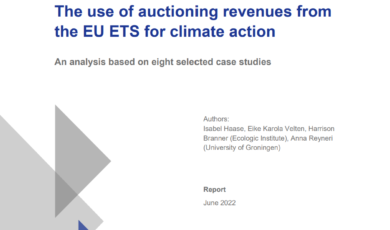How EU member states use carbon market revenues to subsidise fossil fuels
Although EU member states are meant to spend at least half of the revenue from the sale of CO2 allowances on climate action, many are using them as subsidies for the installation of new fossil fuel boilers or to reduce energy prices in industry.

The European Climate Law mandates that the EU reaches climate neutrality by 2050, which requires a huge transformation of its economy and increased investments in climate action from all member states.
The auctioning of ETS allowances is a source of income for member states and could in part finance this transformation. These allowances are pollution permits, which industry needs to buy in order to emit CO2.
EU member states auction off part of their share of allowances which brought in €16.5 billion of revenues in 2020, and €14 billion in the first half of 2021 alone. Moreover, this is only expected to increase further as the reduction of overall emission allowances and phase-out of free allowances could lead to a higher carbon price.
These revenues should provide financing for climate solutions, which is also prescribed in the EU ETS Directive: “… 50% of auctioning revenues from stationary sources and 100% of revenues from auctioning in the aviation sector should be allocated towards climate action”.
And while states mandatorily report on the use of these revenues, there is little to no public insight into how the revenues are actually used by national governments. The study by Ecologic, therefore, analysed the reporting on the use of auctioning revenues since 2013.
It investigates if and how countries designate their revenues (a process known as ‘earmarking’) and if so if those revenues finance real and additional climate action. This was done for eight case studies: Czechia, Germany, Greece, France, Italy, the Netherlands, Poland, and Portugal.
The study was commissioned as part of the LIFE ETX project, funded through the EU-LIFE programme and the European Climate Foundation. Two main findings were drawn from the research.
First, the reporting itself was found to have significant shortcomings. The reports were missing critical information and often contained inaccuracies. Second, not all auctioning revenues reported being spent on climate action incentivise green investment.
All countries spend or have spent part of their revenues on support for fossil fuels, in particular new gas and oil boilers, through building retrofitting programmes. This is, bafflingly, counted towards climate action.
Countries also use the revenues for subsidies for energy-intensive industries, indirectly covering their fossil fuel use. To illustrate this with two case study examples: in 2020 alone, the amount of revenue going to industry subsidies was as high as €293 million in Germany, and €156 million in Poland.
In order to ensure that the EU ETS revenues truly make a valuable contribution to climate action, the study proposes two recommendations. First, all revenues should be spent on real climate action. Currently, only 50% is meant to go to climate action, and even this is not mandatory.
The EU ETS Directive must establish 100% earmarking, exclude fossil fuels and compensation payments, and improve reporting standards. External checks should be in place to safeguard the spending of revenues on climate action. Second, national policy design must ensure traceable long-term funding.
Countries should dedicate the revenues to a limited number of institutions and actions or to funds that ensure proper and transparent allocation, with clear definitions of climate action, that enable long-term investments.
This article was first published as an opinion piece in Euractiv.











